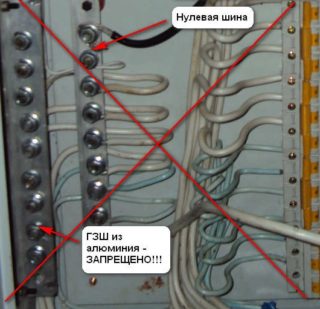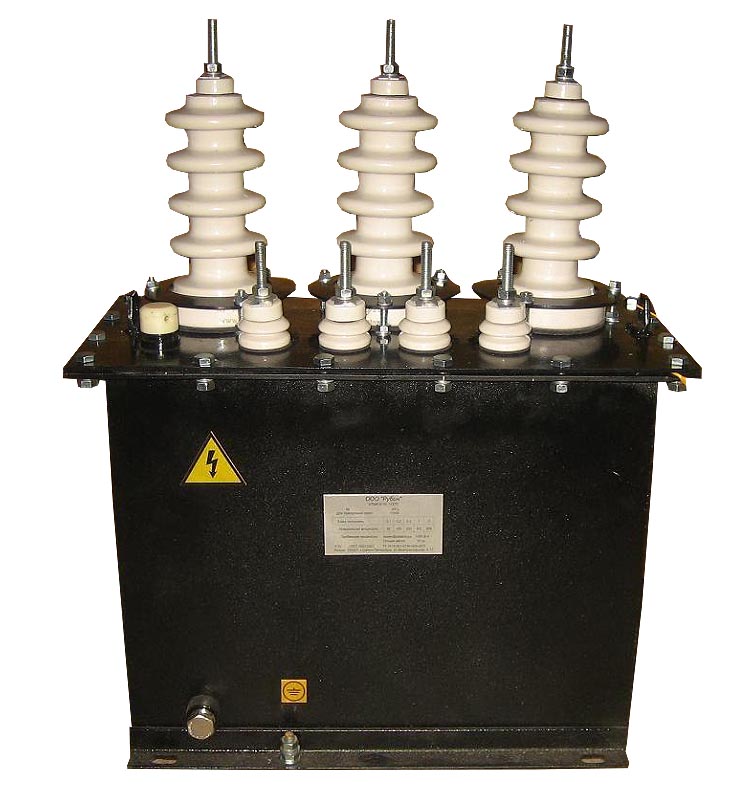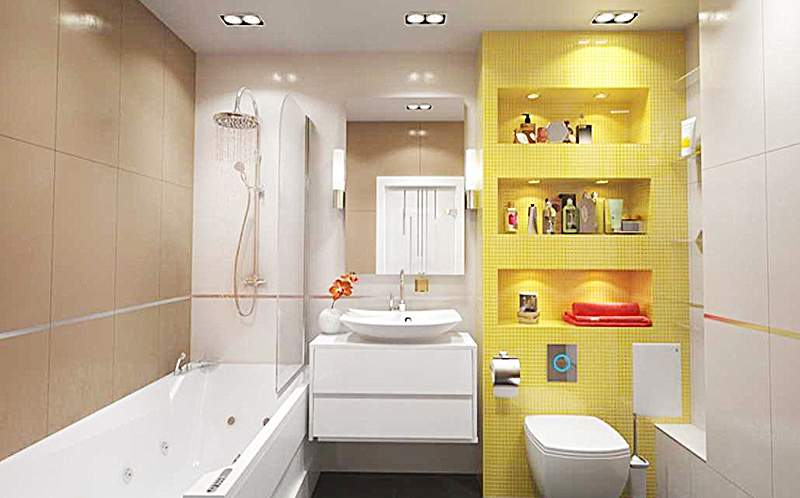The safety of working with electrical equipment is ensured by grounding. In the event of a leak, it conducts current into the ground, so that a person will not be injured when touching metal parts. One of the ways to create protection is the main ground bus. It is designed to connect multiple conductors for grounding and equipotential bonding. The bus can be of different designs, sizes and installation methods. When working with it, you need to take into account a number of nuances so that the installation and subsequent functioning are efficient and reliable.
Grounding bar design
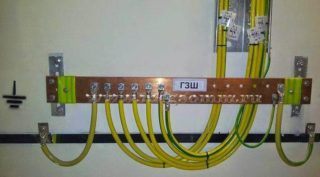
GZSH (main grounding bus) is a protective element that is mandatory when creating any electrical networks. Grounding allows you to protect a person and a home in the event of an emergency or current leakage.
The entire main ground bus system is made of metal (steel, copper). In the role of structural elements, water pipes, gas pipes, steel building elements and other metal parts can be used. Ventilation and air conditioning are often used to create a grounding system.
The PUE requirements allow the use of not only steel, but also copper grounding devices. Steel is used more often because of its cost, but according to its technical characteristics, it is better to use copper. It practically does not oxidize, has good electrical conductivity, is reliable and does not rust. Aluminum is not used as it is susceptible to oxidation and lacks resistance.
GZSH has a smaller cross-sectional area than the protective wire or zero. The section is selected depending on the metal. For copper wires in installations up to 1000 V, an area of 10 sq. Mm is required, for aluminum from 16 sq. Mm, for steel from 75 sq. Mm.
According to GOST requirements, at least five simultaneous connections must be connected to the main grounding bus. Typically, copper bars are capable of connecting 14 or 18 rails at a time. This number of connectors is enough for 10 or more apartments, provided that the load is evenly distributed.
There are two main types of earthing straps, REC-ET2-M and REC-ET. The first type is usually installed in special profiles in assembly cabinets. The tire holder requires a special organizer that protects the device against corrosion, which allows you to connect up to 9 consumers.
Size Requirements
The current regulations indicate what dimensions the tire should have. It should be in the form of a strip on which the required number of contact holes for bolted connections can fit.
For industrial products of the XX-UHL4 TVS brand, the standards are as follows: 3 × 30, 3 × 40, 4 × 40 mm. The number of holes is also standardized - 10, 15 or 20. These dimensions may differ depending on the manufacturer, but all proportions must be maintained. All characteristics of the main ground bus must also be retained.
Application of a security element
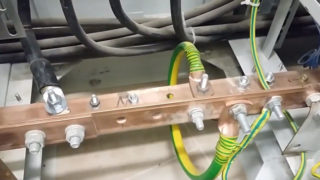
The main grounding bar is a protective equipment. It is used as the main element of the protective circuit for branching lines to residential buildings and industrial buildings. Similar products are used when connecting equipment with voltages up to 1000 V.
The device is a connecting element for several different power consumers.It ensures the operation of the entire grounding system in the building. It must also equalize the potentials in the electrical network. Thanks to the bus, it is possible to separate conductors and connect contacts.
In addition to the main ground bus, the system includes a set of copper connectors and a structure made of metal profiles or reinforcement, which is the ground loop. This contour must be driven into the ground next to the building to ensure reliable metal-to-ground contact.
Typically, the grounding bus collects the conductors coming from the following structures:
- main ground loop;
- casings of pipelines, metal equipment;
- lightning rod.
Also, a PEN conductor is connected to it, which is part of the supply voltage cable connection.
It is important to think over the grounding system even at the design stage of the house.
Place of installation
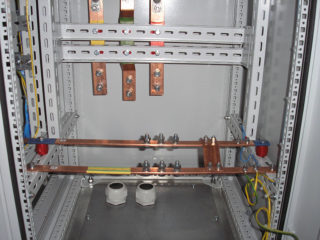
The main bus can be placed inside the entry device of electrical installations. In the case of a stand-alone installation, the bus should be located in a conveniently accessible place.
If the product will be installed in a location accessible only to qualified personnel, an open location should be selected. If there is a risk of access by unauthorized people, you should put the grounding bus in a protective shell - a cabinet, a box, a box with a key. There must be a grounding designation on the shell body, as well as a table with the technical characteristics of the product.
If the building has several separate inputs, the bus is installed on each input equipment. All buses should be connected with a conductor that will equalize the potentials. The cross-section of the wire must be at least half the cross-section of the PE cable. All parts must comply with the requirements of GOST and PUE.
The main way to connect wires is welding. It is distinguished by high reliability and durability, due to which the contact will meet all the necessary safety requirements. Terminals and clamps are also used. They are easy to install and inexpensive, but less reliable than welded and brazed connections.
Protective box installation requirements
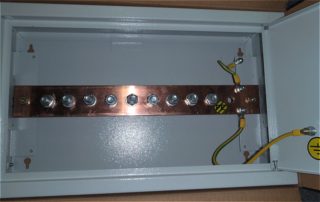
There are special requirements for the installation of the box. The shield must be equipped with a lock so that there is no unauthorized access. It can be placed at a height of at least 150 cm from the floor so that children do not accidentally climb into the box. The place of installation should be chosen taking into account that the environment also affects the operation of the earthing switch. For this reason, in the case of 80% humidity, the air temperature should be approximately 15-20 ° C. At higher or lower temperatures, the reliability of the structure will deteriorate. It is not recommended to place the box in places with aggressive chemicals, as well as sources of fire and heat.
When installing structural elements that implement working grounding, the following points should be taken into account:
- For convenient and reliable installation, fasten the main grounding bar with bolts on the steel box body.
- During installation, it is necessary to connect the grounding bus and the zero rail using a steel or copper jumper.
- The dimensions of the bus should be comparable to the cross-section of the neutral working and protective conductors.
- The installation of wires relative to each other is not regulated by the norms and requirements of official organizations.
The requirements for the cross-section of PE grounding plates also apply. The cross-sectional area must be at least 10 sq. Mm. If copper is selected as the material. If the plate is made of steel, the minimum section is 75 sq. Mm.
On a pole of an overhead line
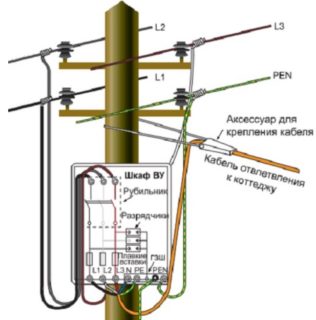
Installation of the main ground bus can be carried out on an additional input device, if available. It can be a pole to which the supply line is supplied. According to the requirements of the PUE and other applicable standards, it is necessary to connect the busbar installed on the pole with the main distribution strip, which is located in the internal input device.
In addition, you should re-arrange the grounding of the PEN wire on the pole by allocating a separate ground bus for it.
Installation outside the cabinet
The main bus can be mounted in places where only professional workers have access. Most often these are factories and production facilities. In this case, it is not necessary to put it in the closet. The bus can be fixed on the surface of an insulator made of durable material. An example of such a product is the TLK 19 ”plate. The grounding bus on insulators is distinguished by its reliability and quality of work. It allows all important plant installations to be grounded.
Built-in tires
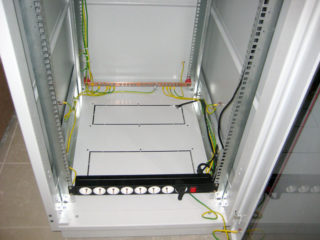
The design is created entirely from scratch by a master. However, there is an already built-in ready-made device with grounding busbars on sale. An example is a DIN rail that comes with a 220V switch to power the device. Also included are zero busbars with an insulator. The maximum number of simultaneous connections allowed is 22.
You can find three types of such rails on sale. DIN U3 is used for circuit breakers, and this model is also available with a zero ground bus. The third type is DIN U4 with additional functionality. All products have an anti-corrosion coating and can be easily wired.
One of the most popular rails is the TLK-ERH-CU 19-inch. Made of copper, it is inexpensive and has a high level of quality.

